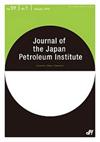负载型镍催化剂制备及利用氢载体
IF 0.6
4区 工程技术
Q4 ENERGY & FUELS
引用次数: 2
摘要
工业革命提高了生产力和生活水平,化石燃料已成为人类社会必不可少的能源。然而,由此产生的巨大消耗引发了严重的环境和能源问题。世界人口的增加和发展中国家的经济增长加速了资源的消耗。因此,一种不依赖化石燃料的新能源系统必须迫切开发。自燃料电池商业化以来,氢已被广泛认为是一种替代能源。目前氢是由化石燃料的重整生产的。因此,为了减少对化石燃料的依赖,需要将可再生能源应用于制氢。然而,太阳能和风能生产的最佳地区往往远离能源消费地区,尽管目前的政策很大程度上依赖于可再生能源来实现低碳社会。因此,从大规模利用的角度来看,将这些可再生能源转化为氢也是可取的。氢的沸点和体积能量密度较低,液化和压缩过程困难。因此,氢载体,含氢化合物,是氢燃料储存和运输的可能解决方案。这些氢载体可以被输送到能源消耗地区,进行重整或分解生成氢。氨、甲基环己烷和甲烷都是潜在的氢载体,因为它们含氢量高,适合大规模生产,易于储存和运输2)。我们专注于二氧化碳和氢气合成甲烷,以及氨分解制氢。本文主要介绍了近年来在负载型镍催化剂上的研究进展。本文章由计算机程序翻译,如有差异,请以英文原文为准。
Production and Utilization of Hydrogen Carriers by Using Supported Nickel Catalysts
The Industrial Revolution improved both productivity and living standards, and fossil fuels have been used as the essential energy sources for human society. However, the resultant enormous consumption has induced serious environmental and energy issues. An increase in world population and an economic growth of developing countries have accelerated the consumption of the resources. Consequently, a new energy system independent of fossil fuels must be urgently developed1). Hydrogen has been widely considered as an alternative energy source since the commercialization of fuel cells. Hydrogen is presently produced by the reforming of fossil fuels. Thus, application of renewable energy to hydrogen production is required for the reduction of the dependence on fossil fuels. However, areas optimum for solar and wind energy production are often far from energy consumption areas, although present policies depend greatly on renewable energy for the realization of a low-carbon society. Therefore, conversion of these renewable energies to hydrogen is also desirable in terms of utilization on a large scale. Hydrogen has low boiling point and volumetric energy density, leading to great difficulties in the liquefaction and compression processes. Therefore, hydrogen carrier, compounds containing hydrogen, are possible solutions for the storage and transportation of hydrogen fuel. Such hydrogen carriers can be delivered to energy consumption areas, and reformed or decomposed to produce hydrogen2). Ammonia, methylcyclohexane, and methane are all potential candidates for hydrogen carriers because of the high hydrogen content, suitability for mass production, and ease in storage and transportation2). We have focused on methane synthesis from CO2 and hydrogen, and hydrogen production by ammonia decomposition. This review mainly introduces our recent research on these reactions using supported Ni catalysts.
求助全文
通过发布文献求助,成功后即可免费获取论文全文。
去求助
来源期刊

Journal of The Japan Petroleum Institute
工程技术-工程:石油
CiteScore
1.70
自引率
10.00%
发文量
29
审稿时长
>12 weeks
期刊介绍:
“Journal of the Japan Petroleum Institute”publishes articles on petroleum exploration, petroleum
refining, petrochemicals and relevant subjects (such as natural gas, coal and so on). Papers published in this journal are
also put out as the electronic journal editions on the web.
Topics may range from fundamentals to applications. The latter may deal with a variety of subjects, such as: case studies in the development of oil fields, design and operational data of industrial processes, performances of commercial products and others
 求助内容:
求助内容: 应助结果提醒方式:
应助结果提醒方式:


